When birds are breeding, we are asking Atlasers to code the behaviors they are seeing from each species in each block. Twenty-two breeding codes are divided into four categories. There are multiple codes in each category, which are explained in detail below. Confirmed is the highest category.
Definitions by Category
- Observed – bird species was identified, no indication of breeding
- Possible – behavior indicates possibility of breeding
- Probable – behaviors are a strong indication of breeding
- Confirmed – breeding activity directly observed
Tips for Using Codes
- When deciding on a code, remember that they are for determining breeding status.
- Know the code definitions (see detailed definitions below)
- If you are new to coding behaviors, start with learning these more straightforward ones:
- Record appropriate codes whenever observed (see #2)
- If you are unsure about a code, use your best judgement for the most appropriate one, and leave a comment with the species!
Quizzes
Test your understanding of the breeding codes with one of our quizzes (note: these are from the NY Breeding Bird Atlas, so some species may not be appropriate for NC!)
Additional Resources
- Breeding Codes – Photographic (courtesy of NYBBA3)
- Guide to Fledglings (courtesy of NYBBA3)
Observed
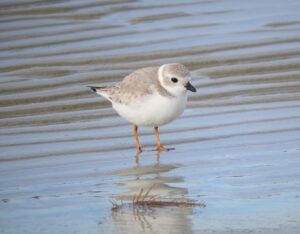
Observed/No Code. Piping plover. © JP Carpenter
No code, checklist in Atlas portal
Species present but without evidence of breeding and outside of suitable nesting habitat. No code is required. Any bird you enter on your checklists in the Atlas portal without a breeding code are automatically Observed. Examples:
- Shorebirds that normally breed in the arctic
- Herons or egrets (colonially nesting species) observed away from a nesting colony (does not include Green Heron and bitterns)
- Gulls frequenting dumps, plowed fields, lawns, etc., throughout the summer
- A Marsh Wren singing from a dry grassy field
- Regionally rare or migrating individuals in unsuitable habitat.
F – Flyover
Birds flying high overhead or in direct flight. This is a behavior code that doesn’t indicate breeding; therefore it is in the ‘Observed’ category. Tree Swallows and other species foraging for insects are not considered a flyover because they are not in direct flight and are interacting with the habitat. Please see this page for more detail.
- Turkey Vulture soaring overhead
- Ring-billed Gull flying above a forest
Possible
H – In Appropriate Habitat
Adult in suitable nesting habitat during its breeding season. Note that this code has both a habitat and breeding season component, which can be very different for residents vs migrants.
- Clapper Rail observed stalking in a marsh in May.
- Scarlet Tanager feeding in a deciduous forest.
- Cormorants or ducks in adult plumage summering on a lake with suitable breeding habitat, but no courtship display or young.
- Green Heron or bitterns (non-colonial nesting species) observed in appropriate nesting habitat.
- A Mourning Dove at a backyard feeder with suitable nesting trees.
- Tree Swallows actively foraging above suitable habitat.
- Field Sparrow in an abandoned field.
- A Black-capped Chickadee in the mountain region giving the chick-a-dee-dee call (which is just a call, not song).
S – Singing Bird
Singing bird giving vocalizations that are used in a mating context, including counter-singing, and present in suitable nesting habitat. This code is also used for non-songbirds giving their primary vocalization, such as woodpecker drumming, owl calls, rail vocalizations, and woodcock peenting. In some species, both males and females sing (e.g., Northern Cardinal, Bicknell’s Thrush). If a bird is heard singing at the same place on a second trip during the breeding season, it may qualify as S7 – Singing Individual Present 7+ Days.
- Rails heard in marsh early in breeding season but not relocated on subsequent visits.
- Woodpeckers drumming. Woodpecker drumming is analogous to singing. Note: It takes a considerable amount of experience to reliably identify woodpeckers by their
- An Eastern Screech-owl calling from your backyard.
- Any bird singing (or giving vocalization that is “song” for the species).
Probable
S7 – Singing Bird Present 7+ Days
Singing male/female present at same location on at least two occasions 7 or more days apart. Do not use if you observed the species singing a week earlier elsewhere in your block. This behavior presumes a permanent territory. This code should only be used if the initial observation was made after migration ceased. Observations must be made within the same breeding season; observations from different years do not apply.
- A Pine Warbler singing from the same group of pines two Saturdays in a row.
- A Barred Owl calling for over a week from the same patch of forest.
M – Multiple (7+) Singing Birds
Multiple (7 or more) singing or territorial birds of a species detected within a block within a single breeding season. If you are submitting separate checklists for different locations and habitats in your block (recommended) and you don’t have all 7 birds on a single checklist, use this code on the checklist where you reach a total of 7 birds and make a note in the comment field that you are including birds from other checklists in the block.
- Rose-breasted Grosbeaks heard in 7 different forest patches in a block throughout June and July.
- 8 Song Sparrows singing in a block in one day.
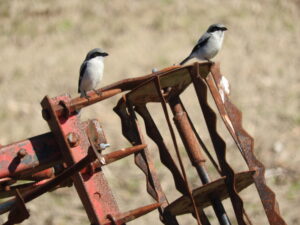
Pair in Suitable Habitat (P): Loggerhead Shrike. © JP Carpenter
P – Pair in Suitable Habitat
Pair observed in suitable nesting habitat. Only use this code when you are fairly certain that a mated pair of birds has been observed. Look for behavioral cues to determine if you have a male-female pair, particularly in species where males and females look the same.
- Male and female Scarlet Tanagers observed together several times in the same area but no nest is found.
- Two Mourning Doves sitting next to each other on a branch, cooing, and preening each other.
T – Territorial Defense
Permanent territory presumed through defense of breeding territory by fighting or chasing. While this is generally used for individuals of the same species, an interaction between members of different species may fall under this code when it appears to be territorial defense. Also see “A – Agitated Behavior.” Because territoriality involves the defense of a fixed area, it may be useful to map locations of individuals to determine if they are defending the same general area when surveying the block on future visits.
- A Field Sparrow chasing another Field Sparrow in a grassy field.
- Two American Robins fighting in your backyard.
- A Swamp Sparrow chasing a Marsh Wren.
C – Courtship, Display or Copulation
Courtship behavior or copulation between a male and a female. Courtship behavior includes transfer of food, displays, and grooming between a pair of birds.
- American Woodcock or Wilson’s Snipe display flights.
- Ruffed Grouse drumming or Spruce Grouse performing flutter-jumps.
- Common Nighthawk booming.
N – Visiting Probable Nest Site
Repeated visits to a probable nest site. This is especially useful for cavity nesters or for a shrub-nesting species that flies into the same thicket and disappears on several occasions.
- A Northern Cardinal flies into a dense shrub and doesn’t come out for several minutes.
- A Boreal Chickadee entering a tree cavity and not coming out for some time.
A – Agitated Behavior
Agitated behavior or anxiety calls from adults indicating a nest site or young in the vicinity. This code refers to a stronger reaction to intruders than those exhibited by “T – Territorial Defense,” usually against brood parasites, nest predators, and humans. Do not use this code for agitation induced by “pishing” or playing recordings. This code also excludes mobbing behavior that species engage in year-round (e.g., mobbing an owl).
- A House Wren begins chattering loudly from a bush as you walk by.
- Common Yellowthroat scolding a Brown-headed Cowbird.
- A mixed flock of birds mobbing a Blue Jay during the breeding season.
- Red-winged Blackbird or Eastern Kingbird attacking a Great Blue Heron.
- A Northern Goshawk or Common Tern dive bombing you.
- A Brown Thrasher chasing a White-eyed Vireo from a patch of shrubbery.
B – Wren/Woodpecker Nest Building
Nest-building by wrens or excavation of cavities by woodpeckers. Wrens may build “dummy” nests before the female selects a nest. Woodpeckers often drill holes for roosting.
- Male House Wren stuffing a nest box with sticks.
- Hairy Woodpeckers building a cavity in April.
Confirmed
PE – Physiological Evidence
Physiological evidence of breeding based on a bird in the hand. This code is used primarily by bird banders and includes evidence such as a highly vascularized swollen incubation (brood) patch, cloacal protuberance, or an egg in the oviduct.
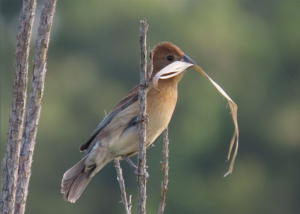
Carrying Nesting Material (CN): Blue Grosbeak. © Karen Lebing; https://macaulaylibrary.org/asset/238202711
CN – Carrying Nesting Material
Adult carrying nesting material to an unseen nest, such as sticks, grass, mud, and cobwebs. For raptors, be sure the material is not simply incidental to prey capture/transport. For wrens, use B.
- Vesper Sparrow flying with a bill full of grass.
- Northern Parula collecting lichen and then flying away with it.
- Barn Swallow collecting mud and then flying off toward a barn.
NB – Nest Building
Nest-building observed at the actual nest site, excluding wrens and woodpeckers.
- Canada Goose moving reeds around and adding mud to build up its nest.
- Warbling Vireo weaving cobwebs into its nest.
DD – Distraction Display
Distraction displays and injury feigning in attempt to draw intruder away from nest or young.
- Killdeer doing broken-wing distraction display but no young seen.
- Ovenbird running about with wings fluttering.
- Ruffed Grouse using a broken-wing display to protect her brood.
UN – Used Nest
Used nest found, but no adult birds seen nearby. Appropriate only if the nest was used during the Atlas period and you are certain of the species. Add comments detailing how you identified the nest. Do not collect the nest, but do take a photograph if possible. Enter ‘0’ if no individuals of that species are observed during your visit.
- A large ground nest in the woods with several large Wild Turkey eggs in it.
- A Bald Eagle nest along the side of a river, but with no eagles present displaying higher breeding behavior.
- Baltimore Oriole nest with no activity but the nest is still in good shape.
ON – Occupied Nest
Occupied nest indicated by adult sitting in nest in incubating position, adult entering nest site and remaining, or exchange of incubation duties by the pair. This code is useful for nests high in trees, on cliffs, and in chimneys where the contents of the nest and incubating or brooding adult cannot be seen.
- Wood Thrush seen on nest for an extended period, but nest too high to see contents.
- Osprey on a nest atop a nesting platform.
- Chimney Swift seen flying into a chimney and doesn’t leave for a long time.
FL – Recently Fledged & Precocial Young
Recently fledged or downy young that are still dependent upon adults and presumed incapable of extended flights from nest site. Look for retained downy feathers, a yellow gape, a short tail (shorter than the wings), clumsy flight and landings, and a bird incapable of feeding itself. Beware of family groups late in the breeding season which may still be interacting but are far from the breeding location. Young cowbirds begging for food confirm both the cowbird and the host species. If you find a dead fledgling and don’t see an adult of the same species, use a count of ‘0’ and enter the FL code.
- Canada Goose family with fuzzy goslings.
- A stubby-tailed juvenile Northern Cardinal incapable of sustained flight.
- Young Common Tern chicks at the nesting site (but outside of the nest) and incapable of flight.
- Young cowbirds begging for food: confirms both the cowbird (FL) and the host species, which probably gets the FY code.
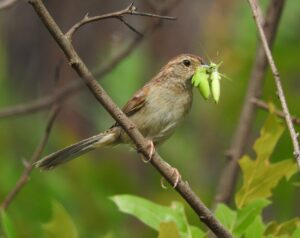
Carrying Food (CF): Bachman’s Sparrow. © JP Carpenter
CF – Carrying Food
Adult carrying food for young or incubating partner. This code should not be used for corvids, raptors, terns, and other species that regularly carry food for courtship, caching, or other purposes. One of the best signs to look for is the repeated carrying of food in the same direction.
- A Hermit Thrush with a bill stuffed full of insects.
- Yellow Warbler carrying a fat green caterpillar.
FY – Feeding Young
Adult feeding young that have left the nest. This code does not confirm breeding for species that may move many miles from the nest site, such as raptors and terns. Use the NY code for nestlings being fed by an adult.
- Eastern Bluebird feeding a begging juvenile in a tree near probable nest site.
- A Black-capped Chickadee feeding chicks in a hemlock tree.
FS – Carrying Fecal Sac
Adult carrying fecal sac or egg shell fragments. Many passerine adults keep their nests clean by carrying membranous, white fecal sacs and broken eggshells away from the nest. Note that only songbirds and woodpeckers produce fecal sacs and this code should only be applied to these groups of species.
- Common Grackle flying out of a shrub with a white fecal sac.
- Carolina Wren carrying an eggshell out of its nest.
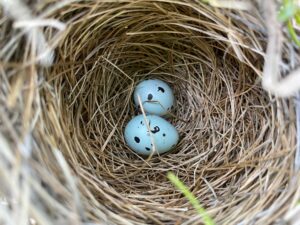
NE – Nest with Eggs: Red-winged Blackbird. © JP Carpenter
NE – Nest with Eggs
Nest with eggs. Be careful not to disturb the vicinity of the nest. Confirm the species by waiting at a distance until adult returns. If no birds are seen, use the UN code. If a cowbird egg is found in the nest, use code NE for both the cowbird and the host species; if no individual cowbirds were seen that day, then enter a “0” in the Brown-headed Cowbird number field during data entry.
- American Robin nest with blue eggs in the low branches of an apple tree.
- Northern Cardinal nest with blotchy eggs in the bushes outside your home.
NY – Nest with Young
Nest with young seen or heard. Keep your distance so nestlings are not prematurely flushed from the nest. Include the nestlings in your species count. Presence of cowbird young confirms both the cowbird and the host species.
- Eastern Phoebe or House Finch nestlings under the eaves of a house.
- Young Osprey calling from a nest platform.


